Matic Network: Scaling Blockchains For Mainstream Adoption
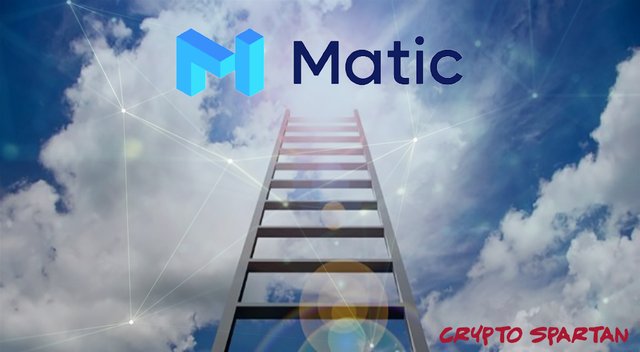
Overview and Vision
Poised to disrupt industries from finance to gaming, and many areas in-between, decentralized applications undoubtedly harness the potential to revolutionize much of our digital and real-world experience. The advent of blockchain has enabled for the first time the creation of applications which do not rely on a centralized party for operation, meaning they can be incredibly more resilient, autonomous, and secure than their traditional counterparts. Immune to single points of failure and censorship resistant, users of decentralized applications benefit from increased control and autonomy.
The potential ramifications of DApps spread far and wide, capturing the imaginations of blockchain enthusiasts around the globe who dream of our decentralized future. However, the blockchain movement has reached a crossroads in its journey to mainstream adoption; we are already encountering hurdles on the DApp development front which present huge fundamental problems if we are to ever take DApps mainstream.
Blockchains are experiencing a conundrum best described by Ethereum founder Vitalik Buterin as the ‘scalability trilemma’. The thesis dictates that of the three foundations of a public blockchain- decentralization, security, and scalability- only two can be effectively prioritized. As the longest-standing and most developed platform, Ethereum represents the most decentralized and secure smart contract platform in existence, but is famously lagging behind on the scalability front due to current infrastructural limitations.
Unable to facilitate mass adoption, blockchains therefore exist today primarily as proof of concept.
Matic believes the answer to mainstream-ready DApps lies in complimenting existing blockchain platforms with a second layer focused on scalability. In this way, Matic can provide massive scaling capabilities whilst leveraging the security and decentralization of the mainchain- an approach allowing for blockchains to achieve mainstream-level scalability without sacrificing any of the characteristics which make blockchains so fundamentally powerful.
The Current State of Blockchains
In their current form, blockchains are simply not able to handle mainstream-level applications. Scalability limitations, poor user experience, slow block confirmations and high transaction fees are all key roadblocks for the mass adoption of decentralized applications. Severely limited by the constraints of their chosen blockchain’s architecture, current DApps are unintuitive and uninteresting, leaving much to be desired in the way of user experience.
Although Ethereum has captured a significant market share- along with the imaginations of many blockchain enthusiasts- on its mission to facilitate our decentralized future, it suffers from crippling scalability issues. The network is consistently congested and the transaction processes are too lengthy to be realistically usable for high-user-volume DApps. Any DApps on the network which do manage to gain significant traction are quickly faced with Ethereum’s scaling issues.
When CryptoKitties overloaded the Ethereum blockchain in December of 2017, the problem was caused primarily by the activity of the DApp’s meagre 14,000 daily users which it had at its peak- a drop in the ocean compared to mass adoption levels. The congestion didn’t just affect users of the DApp; the event impacted the whole Ethereum ecosystem and firmly exposed the scalability limitations of Ethereum 1.0.
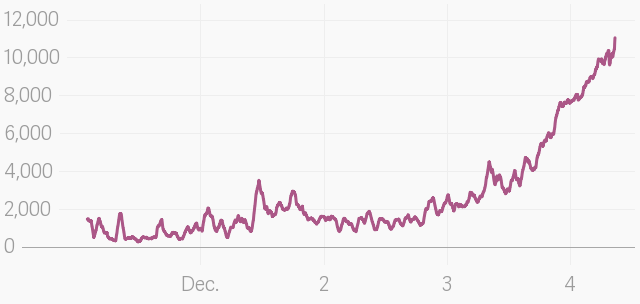
Pending Ethereum transactions after the release of CryptoKitties, December 2017
Even since the CryptoKitties episode, no effective solution has been proposed which can reliably solve Ethereum’s scalability trilemma. Proposed scaling solutions suffer from their own inherent drawbacks in the way of user experience and centralization. It’s clear that Ethereum needs a novel approach if it is to become the reliably fast and scalable smart contract system it was intended to be. Without the Ethereum Foundation building their own, it is the responsibility of open source teams like Matic to facilitate Ethereum’s Layer 2 scaling.
New blockchain platforms are frequently emerging in an attempt to provide an answer to Ethereum’s scalability issues, but carry their own burdens in their trade-off of decentralization and security for the sake of solving the problem of scalability.
Such platforms are also not able to leverage Ethereum’s massive developer base and ecosystem, leaving themselves siloed in their own network facing problematic barriers to developer adoption. Developers wishing to transition to new platforms are faced with onboarding hurdles relating to an unfamiliar programming language and operational mechanism.
Matic’s Solution
Matic believe the key to mainstream-level DApp performance lies in a facilitating seamless user experience and productive developer environment whilst not compromising on the key pillars of blockchain. By providing an innovative solution on layer 2, Matic’s Plasma-based sidechain allow for huge scalability whilst retaining blockchain’s core characteristics of decentralization and security through the mainchain.
With close connections to and active participation in the Ethereum ecosystem, Ethereum will be the first blockchain which Matic will work alongside to scale, but being blockchain agnostic, Matic can work to scale other prominent blockchains in the future.
Technical Strategy
Matic Network employ a dual-pronged approach to scaling whilst retaining decentralization, by utilizing Proof of Stake (PoS) at the checkpoint level, alongside Block Producers at the block production level.
Matic uses Block Producers selected by PoS participants on the base layer, who are responsible for block creation on the Matic sidechains. The system’s checkpointing mechanism ensures that for every few blocks on Matic Network’s block layer, a proposer will be chosen from among the stakeholders to propose a checkpoint on the Ethereum mainchain.
These checkpoints are created after validating all the blocks on the block layer of Matic Network using a Merkle tree of the block hashes from the last checkpoint. The Merkle root is then broadcasted to the network of stakers, who will also verify the proof, and approve the proposed block, if valid, by providing their signatures.
The system needs the approval of ⅔ of the stakeholders to propose a header block to the RootContract, and once the checkpoint is proposed on the mainchain, anyone on the Ethereum mainchain can challenge the proposed checkpoint within a specified period of time. If there is no challenge issued, the checkpoint is formally included as a valid checkpoint on the mainchain.
Matic Network employs Fraud Proofs on the mainchain in order to provide another layer of transactional security, enabling any individual on the mainchain to submit the details of any transactions suspected of being fraudulent. If the challenge is successful, the stakes of the parties involved in the fraud are transferred to the challenger as an incentive for detecting the transaction. This operates as an ongoing community-driven fraud prevention mechanism which also rewards those wishing to contribute their time to upholding the Matic ecosystem.
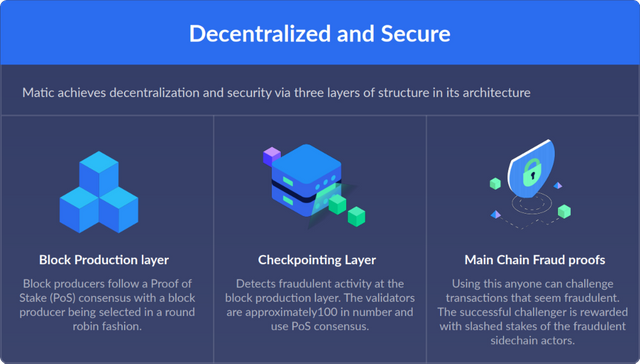
In terms of performance, Matic sidechains offer a powerful solution for any decentralized application. The team have already achieved 6-10k transactions-per-second in a closed environment, and a single sidechain is theoretically capable of up to 65K TPS. Multiple sidechains can be leveraged simultaneously, meaning theoretical scaling to millions of users with ease.
The Matic team have been developing relentlessly, and the alpha-mainnet has already been released ahead of schedule, at the end of June. Matic’s updated roadmap can be seen here:
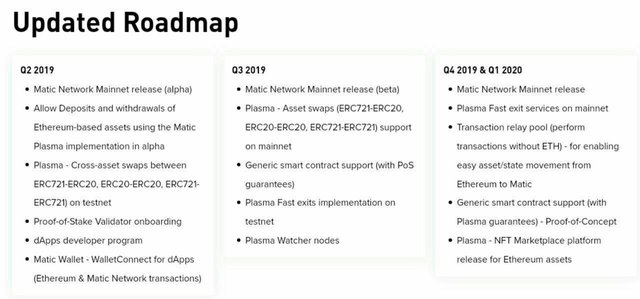
Seamless User Experience
Matic envisage facilitating a blockchain environment which will allow users to pay with, hold or transfer crypto assets without having to concern themselves with the complexities of the underlying infrastructure.
From a user experience perspective, the network will function as follows:
• A user deposits a crypto asset into the Matic contract on the Ethereum mainchain
• Once deposited, tokens get confirmed on the main chain and will appear on the Matic Chain using the Matic Deposit Bridge
• The user can now transfer tokens to anyone almost instantly (as quickly as 1 second or less) and for almost negligible fees.
• Whenever the user desires, they can withdraw their tokens to the main Ethereum chain by establishing proof of their remaining tokens on the RootContract (which is the contract deployed on the mainchain).
When DApps are able to offer an advanced, seamless experience whilst managing blockchain transactions on the back-end unbeknownst to the user- then we’ll truly be on the path to mass adoption. Matic are firm believers that user experience is key in this process, but are also keen not to neglect the architects of our decentralized future.
Developer-Focused Approach
Many blockchains place a strong emphasis on user experience but lack a focus on the experience of those who will actually be building out their ecosystem- the developers. The accelerating frequency of blockchain hackathons, meetups, and conferences globally is a telling indicator of the growing movement for blockchain development and adoption across the board, however barriers to entry and challenges in gaining recognition in the fledgling blockchain space still persist as hurdles for blockchain’s budding developers. Matic not only facilitates a seamless experience for blockchain developers, but also nurtures and guides fledgling developers wherever possible.
The process of building on Matic is designed to be second nature for any Ethereum developer. As Matic is based on the Ethereum Virtual Machine (EVM), any developer on Ethereum is a developer on Matic. A developer can have their Ethereum-based application ported over to a Matic sidechain and begin building within 20 minutes. Matic Foundation is also building an array of tools including wallet, payment API’s & SDK’s, identity solutions and other elements to make it a breeze for developers to design and implement responsive, high-performance DApps on Matic’s infrastructure.
Matic understand the importance of nurturing developer talent in the emerging blockchain industry. Alongside hosting and attending regular hackathons, conferences and events, and conducting active outreach to India’s educational institutions, Matic have recently launched their Developer Support Program. Through the DSP, India’s budding blockchain developers will be provided with technical, financial, talent sourcing and outreach-related support.
Matic aim to empower developers with the means to easily build the applications which will enable our decentralized future.
Competition in the Scaling Arena
As the most pertinent problem facing blockchain today, it’s no surprise that a plethora of scaling solutions have arisen in an attempt to tackle the scalability conundrum each in their own way. Prominent scaling solutions include OmiseGO, Loom Network, Proof of Authority Network, Liquid Network, and Rootstock. In addition to these projects aiming to implement the use of sidechains, there are also a host of projects working on developing state channels to speed up the process of transacting on the blockchain- examples of which include Celer Network and Raiden. Matic also see alternative blockchains such as EOS as ‘competitors’ in the sense that they are attempting to provide an answer to Ethereum’s scalability problem.
Such endeavours offer only a partial solution due to limited functionality, poor user experience or their sacrificing of decentralization for the sake of performance. As a similar sidechain approach, let’s take Loom Network as an example. Since Loom has integrated Plasma Cash, there is no fungibility for the assets supported on the sidechains. Everything there is represented as an NFT/ERC721, meaning payments aren’t natively supported. Further, when utilizing an implementation of Plasma Cash block times will always be longer than those of Ethereum, since every block of the sidechain needs to be pushed to the main chain, while Matic uses checkpoints for 1-second block times.
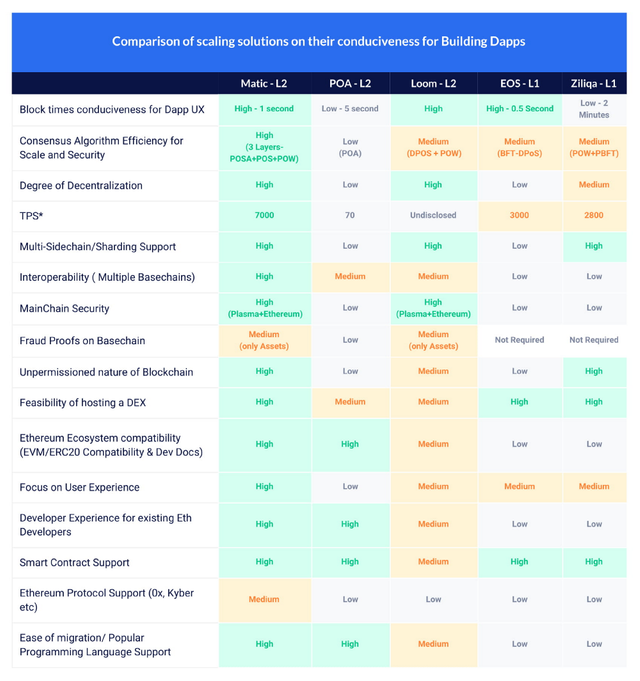
Comparison of scaling solutions, as seen in Matic's article: https://medium.com/matic-network/understanding-ethereum-scaling-categorizing-projects-by-approach-adopted-97c79b25eb55
Matic chains are based on an account based EVM (inspired by Plasma MoreVP) and support ERC721 in addition to ERC20 tokens, along with asset swaps right out of the box. This makes Matic the go-to platform for deploying DeFi applications in particular.
Unlike other scaling solutions, Matic Network is committed to achieving massive scalability alongside decentralization by utilizing checkpoints and fraud proofs on its enhanced version of the Plasma framework. Unhindered by functionality limitations and problems of centralization, Matic will be able to house a wide array of DApps on their infrastructure.
Matic have an excellent comprehensive article on the topic of scaling solutions, a link to which can be found above.
The Matic team are keen to emphasize that to achieve scaling the ecosystem can have many approaches and some of them will complement each other. Hence, there is ample scope for multiple approaches to co-exist and function together. Scaling is not a ‘winner takes all’ endeavour.
Team
As I always say, anybody can write an impressive whitepaper and create a persuasive website; the idea is the easy part, it’s the implementation of the idea which is difficult. In the Wild West of crypto, ensuring that the team has the experience and capability required is crucial- especially when evaluating a project with a vision as fundamentally grand as this.
In the case of Matic, the team’s actions and achievements speak for themselves. Matic is a team comprised of seasoned industry experts who are able to leverage their rich experience of contributing to the Ethereum ecosystem. This includes working on implementations of Plasma MVP, the WalletConnect protocol (which allows users to access Dapps in a secured and user friendly way), and the widely-used Dagger event notification engine.
In fact, if you search 'Plasma Implementers Call' on YouTube you will see Matic CEO Jaynti Kanani discussing Plasma alongside Ethereum titans such as Vitalik Buterin and Joseph Poon in multiple videos.
The Matic team have been active in the space long before their public surfacing as Matic network– they’ve been making valuable contributions to the Ethereum ecosystem alongside Ethereum’s best developers for a long time.
Matic team snapshot, as seen on the Matic website: https://matic.network/about
In addition to fostering valuable connections within the Ethereum ecosystem as they continue their mission to scale the network to mainstream levels, the team also understand the importance of the development of meaningful working partnerships.
Valuable Partnerships
Matic’s innovative solution has captured the attention of much of the cryptospace, leading to the onboarding of and collaboration with some of the industry’s most recognisable projects even at this relatively early stage of development. Matic endeavour to foster partnerships which add value to the decentralized movement, particularly within the gaming and decentralized finance (DeFi) arenas, where the opportunities for beneficial disruption are huge.
Decentraland
Decentraland is a virtual reality platform, powered by the Ethereum blockchain, on which users can create, experience, and monetize content and applications. Decentraland offers a developer toolkit that works on any platform (including all VR headsets and web browsers) and is designed to create virtual environments and applications with relative ease.
Matic is collaborating with Decentraland to scale the transactions that will occur as a result of user interactions within the virtual universe. This will include payments, NFT sales and eventually general game states and other data. Decentraland have announced that they plan to utilize Matic Network to power their entire in-game marketplace. The two teams will also collaborate on research and generalised smart contracts.
Maker Dao
Maker is the organization behind the DAI Stablecoin, which has risen to become the backbone of decentralized finance. Matic Network has partnered with MakerDAO to explore and jointly support the development of dApps which use DAI on Matic Network sidechains.
The DeFi movement carries far-reaching disruptive potential for positive change in the way of increased financial freedom and opportunities for individuals worldwide, and one of Matic’s core aims is working to make impactful DeFi solutions a reality.
0x Protocol
0x is an open protocol for decentralized exchanges on Ethereum. Matic will work with 0x to enable instant, decentralized low-cost trades. Decentralized exchanges are a key component to the overall DeFi ecosystem currently being built to transform old financial products into trustless and transparent protocols that run without intermediaries.
Other partners of Matic include Zebi, Coral Protocol, Ankr Network and Ripio Credit Network, amongst a slew of others.
There are also an increasing number of DApps being built on top of Matic Network, including:
• Incento- A P2P payments application using the DAI stablecoin
• Pocket Full of Quarters- A universal currency for use across various gaming platforms
• Chainbreakers- A strategy-RPG game housed in the Decentraland universe
• Bitwords- An ad exchange for advertisers and publishers
• Plentix- A decentralized platform for the referral economy
Matic’s vision has clearly resonated with the wider blockchain community, and their list of partnerships and collaborative efforts have been growing quite literally week-by-week along their journey thus far.
Summary
When we imagine our decentralized future, we imagine blockchains providing solutions across a whole manner of industries and everyday experiences in a seamless way- the picture does not include the clunky, unintuitive DApps which blockchains are capable of housing today. With the help of Matic’s innovation on the second layer, blockchains can now conceivably exit the proof of concept phase and enter the realm of mainstream adoption, whilst not compromising on the decentralization and security which make DApps so fundamentally valuable.
Though still at the beginning of their journey, Matic have already made huge strides on the platform and business development fronts. With the testnet having displayed impressive performance capabilities and the Alpha-mainnet now live, a slew of projects are lining up to take advantage of Matic’s solution.
Matic Network is positioning itself at the forefront of the scalability movement, not only able to combine with various other scaling mechanisms but also, being blockchain agnostic, able to compliment other blockchains as the overall ecosystem develops. With a primary focus on DeFi and gaming, the team’s priorities lay firmly in facilitating the most beneficially impactful blockchain-powered disruption. This said, as a general-purpose platform able to house a limitless array of DApps, Matic stands to play a prominent role in the furthering of the decentralized ecosystem as a whole.
If the Matic team are able to achieve their objectives, they are poised to make a significant impact on the blockchain ecosystem. In addition to actively helping the Ethereum network to scale to mass adoption-ready levels, Matic’s contribution will grow as they branch out and apply their solution to other leading blockchains which come to establish themselves as critical to the decentralized movement in the future.
Matic’s novel approach to blockchain scaling is systematically designed to overcome the hurdles of the current DApp development space, and may hold the answers to mainstream-level dapp development. I for one will be following Matic’s exciting journey with a keen eye.
Note: this is NOT a sponsored review. I believe in the team's vision and want more people to be aware of Matic's mission.
Have any questions regarding Matic? Join their active community on Telegram where you can discuss anything Chromia-related: https://t.me/maticnetwork
Learn more at their website: https://matic.network/
Dig in deeper with Matic's whitepaper: https://whitepaper.matic.network/
Get connected to Matic on social media:
Twitter: https://twitter.com/maticnetwork
Medium: https://medium.com/matic-network
Disclaimer: this is not financial advice in any form, it is my opinion and insight based on research and you should always do your own research before committing to anything financially whatsoever.

Preach brotha! Scaling is the biggest hurdle we need to solve to move blockchain forward. Two considerations:
So many scaling solutions in the market. I know Matic has advantages over others but we need to see the actual adoption of the tech to see real progression.
I'm not sure Ethereum will be on top as the king od smart contract platforms, it all depends if they can solve their issues quickly enough. There are so many competing platforms now which prioritize performance so can offer better scaling than Eth. Time will tell.
p.s. glad to see you back on it bro! Keep it up.
Thanks @rashisonto! Great questions, defnintely good considerations.
Unlike other scaling solutions which either attempt to overcome the scalability trilemma by sacrificing decentralization or lack the functionalities of Matic, or others which are tailored towards more specific usecases (e.g. Loom with gaming), Matic is designed to be an all-purpose platform able to house any type of Dapp on top of its infrastructure. Matic is also going above and beyond to build out an entire wider ecosystem of developers and Dapps. For a comparison of scaling solutions to Matic I'd highly recommend this blog post, it spells out scaling solutions really well:
https://medium.com/matic-network/understanding-ethereum-scaling-categorizing-projects-by-approach-adopted-97c79b25eb55
And when it comes to Ethereum, as well as the improvements made via the Ethereum 2.0 upgrades. No other smart contract platform is as decentralized as Ethereum, and they often neglect decentralization as part of their design in favour of scalability. They also lack the massive developer ecosystem Ethereum has- the vast vast majority of blockchain devs are Ethereum devs.
Thankyou I will take a look. Looked into Loom a bit and wasn't too convinced. But I didn't know as much about scaling at the time.
Great analysis spartan! Love MaticNetwork, $MATIC looks like it will be on its own moon mission soon along with $BTC. Keep spreading the knowledge!
Thanks for your support @aldusfaustlela! Matic is a long-term HODL of mine, I think they've got a very bright journey ahead of them myself.
thank u sir do you know where I can find news of price pump
Aside from their social media, Matic have an announcement channel on Telegram which is the best place to keep up to date with the latest news. You can find it here: https://t.me/maticnetwork_announcements
I believe the recent price spike is due largely to Coinbase mentioning they're considering listing Matic. HUGE news!
thank u very much
To listen to the audio version of this article click on the play image.

Brought to you by @tts. If you find it useful please consider upvoting this reply.
good info, I am new to Steemit a follow would be appreicate. I will follow you along for updates
Thanks for your support!
If Matic can get their ecocystem up and running I think we're looking at a top 20. BUT it's a big if. Much harder to actually roll out finished tech than starting to develop
Yep it all depends on execution. In the case of Matic they've already released their alpha-mainnet and are on schedule with their rodmap. Dapps are onboarding at an incredible rate, and collaborative partnerships with many top projects. Overall progress is looking very strong.